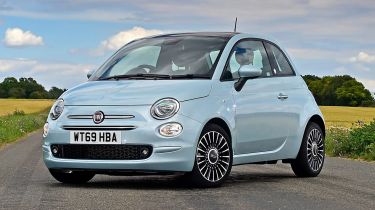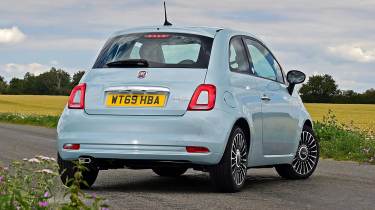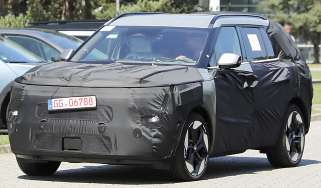Used Fiat 500 (2008-date) buyer’s guide: stylish city car is cheap and cheerful
A full used buyer’s guide on the Fiat 500 city car that’s been on sale in the UK since 2008
Verdict
It may be an old design now, but the Fiat 500 still looks reasonably fresh and appealing. With lots to choose from and some very keen prices, it’s easy to be tempted by this chic city car. The good news continues with low running costs – if you’re not stung by a series of repair bills. The 500 isn’t as good to drive as you might hope, and the build quality leaves a lot to be desired in some areas. Many people have enjoyed years of trouble-free ownership, though, so if you can live with the Fiat’s shortcomings, it’s a question of finding a cherished example and locating a specialist to keep it maintained.
When Fiat took on BMW’s MINI by introducing its own chic small hatch, it was the Italian company’s saviour.
It’s now 17 years since the 500 was reintroduced (after the original 1930s’ Fiat 500), but it didn’t take long for the reborn 2008 model to account for more than 80 per cent of Fiat’s sales, things maybe helped by scooping the 2008 European Car of the Year title.
The Fiat 500 was recently axed in ICE form, but the electric-only 500e (launched in 2020) remains on sale. It falls outside the scope of this guide, however, because it’s a different car that is based on its own platform.
History
January 2008 saw the 500’s arrival with 1.2 or 1.4-litre petrol engines, or a 1.3 turbodiesel. The 1.2 Start&Stop was launched a year later, and the 135bhp 1.4 turbo Abarth followed soon after, with the open-topped 500C coming in July 2009.
Used - available now
In February 2010 the 1.3 diesel unit was refreshed to give 95bhp (an increase of 20bhp), along with better fuel economy, thanks to Start&Stop tech. Then in August 2010 the 85bhp two-cylinder 875cc TwinAir arrived.
From May 2014 there was a 105bhp TwinAir option, too, while revisions at the end of 2015 included fresh infotainment systems and tweaked exterior styling. In January 2020 a 1.0-litre non-turbo, mild-hybrid 500 went on sale; within a year this was the only powertrain left available. The line-up was revamped in February 2021 to encompass Pop, Connect, Dolcevita, Cross and Sport trims.
On the road
The 500 is best on urban streets, where its compact dimensions and great all-round visibility allow it to excel. Its City Steering mode ensures parking is a breeze, by making the steering ultra-light. The downsides are that the steering offers little feel whatever mode you pick, and the suspension is firm, while performance isn’t great with any of the engines. However, if you want more poke, there are always the various Abarth editions.
Which should I buy?
The 1.2-litre is fine off the motorway, but the 1.4 is much perkier, while the diesel is worth a look if you’re a high-mileage driver, but it doesn’t offer quite as much fun. The TwinAir is quick, but thirsty if you use its full performance.
Trim and kit levels changed during production, but in general there were three key specifications: Pop, Popstar/Sport and Lounge. The Pop had remote central locking, electrically adjustable door mirrors, powered front windows and a multifunction steering wheel, while Sport/Popstar added air-con, alloy wheels and a split-folding rear seat. The Lounge had a glass roof, DAB radio, rear parking sensors and extra chrome trim.
Use our valuation tool to check the price of a Fiat 500
Alternatives to the Fiat 500
The most obvious rival to the 500 is BMW’s MINI, which is better to drive and also plentiful, but you will pay more for something that’s directly equivalent. Citroen’s take on the premium supermini was the DS3 (sold under the DS brand from 2016), and this is a bit more practical, as well as great value for money as a used buy.
The Vauxhall Corsa-based Adam looks smart, is cheap to run and tends to be well equipped too, but is short on practicality. The Volkswagen up!, SEAT Mii and Skoda Citigo are basically the same and all offer a big-car feel with excellent practicality, while the Kia Picanto and Hyundai i10 should also be checked out. Two other models worth shortlisting are the Alfa Romeo Mito and Ford Ka.
What to look for
Fuel economy
The 1.2-litre non-turbo engine can achieve 55mpg easily. The perky TwinAir is potentially great fun, but fuel economy can dip to just 35mpg.
Build quality
interior trim can be fragile, with bits breaking or falling off. The seat-tipping mechanism and door handles can be trouble, with the latter a particular weakness.
Transmission
Premature clutch failure isn’t rare with petrol 500s. Clutches tend to last longer on the diesels, but their dual-mass flywheels can bring problems of their own.
Problems with parts
Owners’ forums feature tales of shock absorbers, radiators, wheel bearings, exhausts and air-con compressors failing earlier than expected. An MoT/inspection is recommended before buying a used 500.
Interior
In a world of digital display screens and touch-sensitive buttons, the 500’s dash is a breath of fresh air, thanks to its simple layout. But the quality of some of the switchgear isn’t so good, and the Fiat’s budget positioning is all too apparent in places. It’s the same story with some of the interior plastics.
But where the 500 really falls down is practicality. Front-seat passengers have lots of space, but those behind will find things cramped. The Fiat is best viewed as a two-seater with a decent boot if you drop the back seats down; just bear in mind that a lot of 500s don’t come with a split-fold facility. Boot capacity is 185 litres with the backs seats in place, or 550 litres with them folded down.
Running costs
Diesel-engined 500s need to be serviced every 12 months or 12,000 miles. Petrol-engined 500s stretched this to two years or 18,000 miles until 2017, when it was reduced to 12 months or 9,000 miles. Maintenance alternates between minor and major, priced at £199 and £349 respectively.
The diesel and TwinAir engines are chain-driven, but the 1.2 and 1.4-litre petrols have a cambelt that has to be replaced every six years or 72,000 miles, at £510. Insurance generally starts at group 5 (the hybrid Hey Google is two groups lower), while most 500s sit in groups 8-11, although diesels are rated in group 15 and sporty Abarth editions sit in groups 25-28.
Recalls
Fiat has recalled the 500 20 times so far, with the first two coming in January and April 2009 because of fuel leaks and faulty brakes. Further actions covered steering faults and airbag glitches (both in 2010), then additional brake problems led to another campaign in 2012.
Fuel leaks and lighting failures prompted recalls in 2014 and since then there have been issues with the seatbelts, instrumentation, stop/start system and electrical short circuits. Other potential problems have centred on steering and driveshaft parts, with the most recent recall coming in September 2022 because of the possibility of a failure within the steering mechanism.
Driver Power owner satisfaction
The 500 first appeared in a Driver Power New Car survey in 2009, in 86th place out of 100; in our 2024 poll it was 49th out of 50. It came last for practicality (including rear-seat legroom), safety features, powertrains, brakes and handling, and scored badly in most other areas.
Highlights were fourth for running costs, 19th for fuel economy and 18th for the exterior styling, but 48th for the interior design isn’t great.
SEE OUR LATEST USED FIAT 500 DEALS
Did you know you can sell your car with Auto Express? Get the highest bid from our network of over 5,500 dealers and we'll do the rest. Click here to try Free Car Valuation tool...










